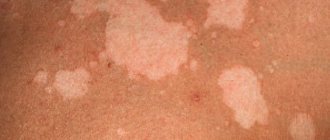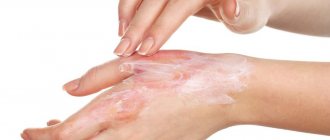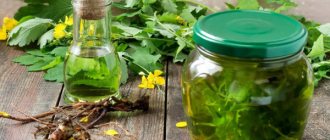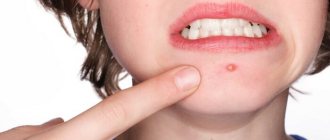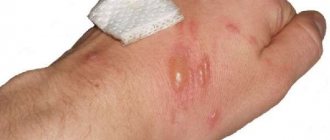Tanning is a change in the shade of the epidermis to a darker one under the influence of ultraviolet radiation, which enhances the production of melanin (the pigment responsible for the color of the skin, hair and eyes).
Sometimes, after sunbathing, incomplete “coloring” of the skin is noted with the formation of “islands” of white, red or brown color. Insufficient pigment production may be due to the presence of various skin pathologies and is expressed by the formation of white spots on the epidermis.
Causes of light pigment spots after sunbathing and their symptoms
List of the main reasons for the formation of white spots on the skin with a brief description:
| The reasons that caused the formation of stains | Factors provoking the development of deviations | Symptoms |
| Sunburn | Long-term exposure to active ultraviolet rays on the epidermis. |
|
| Potent medications | Taking medications that increase the skin's sensitivity to ultraviolet rays (antibiotics, hormonal agents). As a result of their influence, melanin is unevenly distributed in the epidermis, which provokes the formation of white and dark spots. |
|
| Having a fungal infection on the skin | Infection with the fungus can occur through personal contact with a carrier of the pathogen or through objects used by the patient. People with reduced immunity are susceptible to infection. |
|
| Skin pathologies of an infectious nature (accompanied by a rash) | Contact with the patient or objects he used. | Symptoms are individual for each disease. A distinctive feature is the presence of a rash, after elimination of which the skin is gradually restored and uneven tanning is possible when sunbathing. |
| Vitiligo | The disease is characterized by impaired production and distribution of melanin on the epidermis. May be caused by:
It can also develop as a complication after a dermatological disease. |
|
| Poikiloderma | It is expressed by depletion of the skin and the formation of dark and light spots on it. The disease can be inherited. The acquired form develops as a result of:
After skin pathologies, as a complication of an illness. |
More often, poikiloderma develops in people with fair skin tone. |
| Hormonal disbalance | Pathology can be caused by:
|
|
| Prolonged pressure on the skin | When you stay in one position for a long time while sunbathing, the blood supply to certain areas of the skin deteriorates, which causes uneven distribution of the tan. |
|
| Presence of foreign objects when sunbathing |
|
|
| Presence of scars | These formations can occur as a result of injury after surgery. In the damaged area, melanin may not be produced or may be formed in small quantities. |
|
| Hypomelanosis | Uneven distribution of melanin is a genetic disorder |
|
| Sun cream or sunscreen | Uneven application of the formulations causes uneven distribution of the tan. |
|
The secondary reasons for the formation of white spots after tanning are:
- reduced immunity;
- prolonged and frequent stress, depression;
- insufficient intake of vitamins and minerals;
- allergic reactions.
These factors provoke uneven distribution and production of melanin, and also make it easy for the above diseases to occur.
Why do white spots appear after sunbathing?
The cells of the epidermis contain melanin, a special pigment that not only determines skin tone, but also absorbs UV radiation, protecting against burns. Under the influence of sunlight or solarium lamps, the body begins to actively produce large amounts of this substance (the process occurs in special cells - melanocytes), and the epidermis, accordingly, becomes darker.
However, in some areas of the skin, the described process may not occur under the influence of ultraviolet radiation, and then white spots (lighter than tanned skin) appear. This happens if:
- ultraviolet radiation does not have access to certain areas of the body;
- Melanocytes are absent in some areas of the dermis;
- melanocytes do not cope with their function;
- the melanin produced cannot penetrate the upper layers of the skin;
- There are areas where there is no melanin.
All these factors can be due to a number of reasons; we will focus on the most common of them.
Non-compliance with tanning rules
Sometimes, after exposure to the sun, white, untanned areas remain on the body. Most often this is: the inner thigh, sides of the torso, neck. This happens due to an incorrectly chosen tanning position, as a result of which UV rays simply cannot penetrate to some areas.
For an even tan without white spots, it is better to tan while moving.
In rare cases, white spots can be the result of uneven application of sunscreen: if only certain areas, such as the nose or shoulders, are treated, these areas will appear less tanned than the rest of the skin.
Burns
Excessive tanning can lead to burns, which result in peeling skin. The young cells that appear at the site of the rejected epidermis contain melanin only in small quantities, since they were not exposed to ultraviolet radiation, and therefore look lighter than healthy, tanned areas.
Excessive sweating
With increased work of the sweat glands, fungus or other pathogenic bacteria can spread across the skin, preventing melanin from penetrating into the upper layers of the skin. As a result, white spots appear - untanned areas.
I have the same thing on my skin after sunbathing.
I went to the dermatologist. She told me that the acidity of my sweat had changed. It is completely impossible to cure, but it is better to wear only cotton underwear, no synthetics. Shurshara
https://www.u-mama.ru/forum/family/health/538376/
Scar tissue
As a result of injuries and some inflammatory pathologies, after the skin heals, scars may appear that vary in depth and area. They are formed from connective tissue that does not contain melanin, so these areas cannot tan, remaining white.
Therapy with certain drugs
Taking certain medications can cause uneven pigmentation, including:
- hormonal contraceptives;
- some antibiotics;
- diabetes medications, etc.
Genetic and acquired diseases
White spots often indicate the presence of some kind of pathology, here are the most common ones.
Vitiligo
Vitiligo is a pathology caused by genetic predisposition and autoimmune processes in the body, leading to the absence of melanocytes in certain areas of the dermis.
Vitiligo spots on tanned skin become more visible
The disease manifests itself as light (pink or white) spots of irregular shape with clear outlines. Usually the formations are localized on the arms, legs, around the eyes and mouth, and near the ears. After exposure to direct sunlight, they become even more noticeable compared to tanned areas of the skin.
I also have spots on my body, for 2 years now!
Moreover, they multiplied unexpectedly for me! I thought that they were only on the hands and on the pubis, but it turned out between the shoulder blades, on the outer sides of the thighs! In a word, everywhere! (((During the winter, the skin of my face became quite white, only an imperceptible dark spot remained on the chin, memories of the previous skin color. It all started from excessive exposure to the sun, in general I really loved this! I live in the south and imagine what I have to work hard to hide from the sun in the summer! Otherwise, the contrast in the color of my skin will be much stronger! I saw a doctor, even at the initial stage of the disease, so he said without any tests - vitiligo! Renatic
https://www.medsovet.info/forum/topic_5644
Video: doctors about vitiligo
Guttate hypomelanosis
Guttate hypomelanosis is a genetic disease that is associated with intense destruction and delayed formation of melanin. The disease begins to progress under the influence of ultraviolet radiation.
It usually appears as white droplet-shaped spots on the arms, legs, back and shoulders.
Guttate hypomelanosis is usually found on the extremities, back and shoulders
Pityriasis versicolor
Pityriasis versicolor, or pityriasis versicolor, is a disease of infectious origin that occurs as a result of penetration of a special yeast fungus into the upper layer of the epidermis.
Pityriasis versicolor is often discovered after sunbathing: the spots become more visible under the influence of ultraviolet radiation
Outwardly, this manifests itself as spots of different shapes and shades without clear boundaries, which “merge” with each other over time. Usually the formations are concentrated on the chest and back, in rare cases - on other parts of the body.
Unlike vitiligo, with pityriasis versicolor, melanocytes are present in the skin and produce melanin, but the fungus prevents the pigment from penetrating the upper layers of the skin.
Under the influence of ultraviolet light, the spots begin to lighten and look white against tanned skin.
This is pityriasis versicolor, it happens to many people... Doctors also call it beach sickness.
A friend treated him for 2 weeks, applied local ointment and voila, he’s been walking smoothly for 2 years now)) Candy
https://www.woman.ru/beauty/body/thread/4014166
Video: doctor about pityriasis versicolor
Secondary syphilis
In the modern world, secondary syphilis (syphilitic leukoderma) is rare. Under the influence of the causative agent of the pathology - Treponema pallidum - characteristic rashes appear on the skin, after which depigmentation of the skin appears.
With secondary syphilis, white spots disappear after characteristic rashes
White spots, the size of a small pea or coin, usually appear on the thighs, lower abdomen, chest, neck, and upper back. These areas become even more noticeable against the background of tanned skin.
Poikiloderma Siwatt
Poikiloderma Siwatta is an atrophic skin disease that manifests itself as white spots on the skin, rashes and patchy pigmentation.
Presumably the causes of the pathology are:
- vitamin deficiencies;
- ultraviolet;
- toxic-allergenic agents;
- wearing chains made of certain alloys (including nickel).
Poikiloderma Siwatt spots focus on the chest and neck
The lesions are usually concentrated on the neck and chest.
Other malfunctions of the body
Sometimes the body does not produce enough melanin, and some areas of the skin remain undarkened after tanning. This may happen due to:
- kidney and liver diseases;
- thyroid dysfunction;
- hormonal disorders;
- infections;
- nervous stress and depression.
The appearance of such spots indicates a loss of melanin pigment and is often the result of excessive tanning.
However, white spots on the skin can be a symptom of diseases (skin, genetic, such as vitiligo or pityriasis versicolor). On pale skin they are not noticeable, but after tanning they become especially noticeable. Sergey Agapkin, doctor, host of the program “About the Most Important Thing”
https://www.aif.ru/health/secrets/chto_za_belye_pyatna_inogda_poyavlyayutsya_na_kozhe_posle_zagara
White spots appear in children for the same reasons as in adults. However, the baby’s immunity is very weak, so you should be as attentive as possible to the issues of his health. If white spots are detected in a child, you should immediately contact a dermatologist.
The origin of white spots that appear due to an incorrectly chosen tanning position usually becomes clear immediately. In other cases, it is recommended to consult a dermatologist to determine the cause.
When should you see a doctor?
White spots on the skin after sunbathing may often have a pathological origin. A diagnosis by a dermatologist is required, with possible subsequent examination by other specialists (depending on the disease).
You should consult a doctor if you have the following symptoms:
- spots increase in size, spread further throughout the body or remain on the skin for a long time;
- there is itching, peeling;
- increase in temperature indicators;
- deterioration in general health;
- formation of ulcers or cracks.
To eliminate the spots, drug treatment will be required, which is determined only after diagnosis.
Diagnostics
Initial diagnosis can be done by a general practitioner/pediatrician or dermatologist.
The examination consists of the following stages:
- Interview with the patient: the presence of chronic diseases is determined; Are there any additional symptoms and what? what chronic and genetic diseases do close relatives have? does the patient use cosmetics, and what kind; whether antibiotics or hormonal drugs are being taken.
- Examination of the patient: visual inspection of the spots; identification of additional symptoms (peeling, soreness, thickening of the skin); determination of the localization zone.
- Taking tests. It is performed to determine the general condition and detect infection.
- Scraping from the affected area. Required to confirm or exclude the presence of a pathogen.
- Transillumination of the epidermis with a Wood's lamp. Allows you to identify fungus. When exposed to rays, the skin acquires a green or bluish tint (depending on the type of fungus).
If necessary, an ultrasound and MRI may be required to identify hidden pathologies in the body.
Drug treatment of white spots in children and adults
White spots on the skin after sunbathing, if the presence of pathology is confirmed, can only be eliminated by taking medications (orally or externally). Additionally, physical or hardware procedures and diet may be prescribed. With the permission of a specialist, folk remedies can be used.
Sunburn
A sunburn occurs as a result of prolonged exposure to ultraviolet radiation on a specific area of the skin. As a result, damage to the epidermis occurs, accompanied by redness and blistering. After the formations are eliminated, a white spot forms on the body. To eliminate a burn, a specialist prescribes the following types of drugs.
| Name and release form of the medicine | Age restrictions | Rules of application |
| Painkillers and restorative ointments | ||
| Contractubex (ointment, gel) | There are no contraindications | The compositions are applied 2-3 times a day to the affected area for 4 weeks. The products prevent the formation of scars on the affected area. |
| Solcoseryl (ointment) | Up to a year, use is possible only after agreement with the pediatrician | The ointment is used 2-3 times a day until the skin is restored. Accelerates the process of cell regeneration. |
| Panthenol (spray and ointment) | Contains no contraindications | The products are used 1-5 times a day until symptoms disappear. The use of a spray is recommended. Allows you to quickly eliminate inflammation and speed up the recovery process. |
| Oral painkillers (prescribed when it is difficult to use external medications due to severe pain) | ||
| Nurofen (tablets) | After 6 years | Take 1 tablet 3 times a day for 3 days. For children under 12 years of age, the dosage is calculated individually. The drug is also available in the form of a gel for rapid external pain relief. |
| Ketanov (tablets) | After 16 years | Tablets are used 2-4 times a day, 1 piece. no more than 5 days. Tablets only eliminate the pain symptom, but not the cause of the pain. |
| Disinfectants. Required if blisters are present | ||
| Betadine (ointment, solution) | After 1 year | The composition is applied up to 5 times a day until the skin is restored. Has virtually no side effects. |
| Miramistin (solution) | There are no contraindications. For external use. | Wash the affected skin area with the solution 2-3 times for 5-7 days. The use of miramistin is allowed before using restorative ointments. |
| Ichthyol (ointment) | After 12 years | The composition is applied 2-3 times a day for no more than 14 days. Additionally, it relieves pain in the treated area and accelerates the process of cell regeneration. |
Timely and correct removal of the burn will reduce the likelihood of white spots forming in the future after sunbathing.
You can speed up the process of eliminating stains with the use of drugs (done only in consultation with your doctor):
- deep peeling. Allows you to speed up the skin restoration process;
- cryotherapy. Blood supply and metabolic processes are normalized, which accelerates the process of cell regeneration;
- phototherapy. Allows you to eliminate inflammation and speed up the recovery process.
Hardware treatment is performed after eliminating blisters and redness at the burn site.
Taking medications
When white spots form due to antibiotic or hormonal therapy. It is required to avoid sunbathing for the period of treatment and 2-3 weeks after completion of the course. If a disturbance in the production of melanin by other medications is detected, the attending physician will adjust the therapy by replacing the drugs with analogues.
Fungal infection
The skin affected by a fungal infection becomes covered with light spots after sunbathing. The spores of the pathogen do not allow ultraviolet rays to penetrate the epidermis, resulting in the formation of white “islands.”
Drugs used to eliminate fungal infections:
| Name and release form of the medicine | Age restrictions | Rules of application |
| Antifungal ointments | ||
| Exoderil (cream, solution) | In childhood, use is possible with the permission of a pediatrician | The composition is applied to the affected area once a day for 14-28 days. |
| Clotrimazole (gel, cream, ointment) | The products are used 2-3 times a day until the fungus is eliminated, but not more than 4 weeks. | |
| Mycozolon (ointment) | After 2 years | The composition is applied 2 times a day for 2-5 weeks. |
| Antifungal tablets (prescribed in advanced forms of the disease) | ||
| Nizoral (tablets) | After 3 years | Take 1-2 tablets for 2-4 weeks. If necessary, treatment is extended, but not more than 6 months. Shampoo and cream are also available and have no age restrictions. |
| Orungal (capsules) | No restrictions | The dosage and course of treatment are prescribed individually according to the patient’s age and the severity of the pathology. |
| Ointments that accelerate the recovery of the epidermis | ||
| Bepanten (ointment, cream) | Allowed for use from birth | The composition is applied up to 5 times a day until the skin is restored. |
| Calendula (ointment) | There are no contraindications based on age | The ointment is used 2-3 times a day for 7-14 days. |
| Argosulfan (cream) | Use allowed after 2 months | The cream is applied 2-3 times a day until symptoms disappear, but not more than 2 months. |
| Antihistamines to relieve itching and swelling | ||
| Tavegil (tablets, syrup) | After 1 year | The dosage and duration of treatment are selected individually. |
| Zyrtec (tablets, drops) | No restrictions | |
To speed up the restoration of the skin, after eliminating the fungus, it is possible to use hardware methods (after the permission of a dermatologist) used after a burn.
Vitiligo disease
Vitiligo is characterized by a violation of the formation of melanin in the skin. The disease requires long-term complex treatment by a dermatologist.
Vitiligo is a disease that causes white spots on the skin that become especially noticeable after sunbathing.
Drugs used:
| Name and release form of the medicine | Age restrictions | Rules of application |
| Medicines that support melanin levels | ||
| Melagenin (lotion) | In childhood, use only under the supervision of a pediatrician | The course of treatment is selected individually according to the degree of damage to the skin and age. |
| Diprospan (suspension for injection) | ||
| Levamisole (tablets) | ||
| Ammifurin (solution, tablets) | ||
| Shilajit (tablets) | ||
| Vitamin complexes | ||
| Vitamin E (capsules) | After 6 years | Take 2-3 capsules for 2-3 months. |
| Ascorbic acid (dragees, tablets) | After 3 years | Take 1-3 tablets for 30 to 60 days. |
| Thiamine (tablets and capsules) | After 4 years | Take 1 capsule/tablet 3 times a day for 90 days. |
| Hormonal ointments | ||
| Lorident (ointment) | After 10 years | The composition is applied 2-3 times a day for 2 weeks |
| Fluorocort (ointment) | From 2 years | The ointment is used 2-3 times a day for 10-14 days. |
Among the hardware methods, phototherapy is used. Only the affected area of skin is exposed to irradiation. Before carrying out the procedure, consultation with a specialist is required.
Poikiloderma
The disease requires long-term use of drugs. Complex treatment includes the use of the following medications.
| Name and release form of the medicine | Age restrictions | Rules of application |
| Hormonal ointments | ||
| Flucinar (gel, ointment) | After 2 years | Apply 1-2 times a day for 7-14 days. |
| Celestoderm (cream, ointment) | After 6 months | The composition is used 2-3 times a day for 7-10 days. |
| Flucicort (cream) | In childhood, use only with the permission of a pediatrician | |
| Vitamin complexes | ||
| Pikovit (syrup, tablets) | Syrup is approved for use from birth, tablets after 4 years | A single dosage is calculated based on the patient’s weight, taken 1-3 times a day for 30 days. |
| Alphabet (tablets) | After 1 year | |
| UV protective ointments | ||
| AVENE | The products are used before going outside. Rules for use and application are discussed in the instructions. Use in children is not recommended | |
| Sol Bianca Sun Protect Complex | ||
| AQA baby | Allowed for use from birth | Apply before going outside. |
| Ointments to even out skin tone | ||
| Iclain (cream) | In childhood, use only with the permission of a pediatrician | Apply 1-3 times a day for 7-14 days. Longer use should be confirmed with the treating specialist. |
| Bark (cream) | ||
| Evinal (cream) | ||
Folk remedies for the treatment of this pathology are not recommended. Replacement of medicines with analogues is carried out only by the treating specialist.
Hormonal disbalance
White spots on the skin after sunbathing can be caused by a hormonal imbalance in the body (adolescence, pregnancy, menopause). To eliminate formations, the treating specialist prescribes hormonal drugs and vitamins for internal use.
Additionally, hardware procedures (used for sunburn) may be prescribed.
Prescribed medications:
- hormonal agents (Qi-Klim, Duphaston, Clomiphene);
- vitamins (Complivit, Vitrum).
There is no treatment during pregnancy. The hormonal background levels out on its own after delivery.
How to get rid of white spots on skin
Methods for getting rid of white spots depend on the cause of their appearance. If the formations are the result of a violation of the basic rules of tanning, several sessions of sunbathing will be required in compliance with these rules; in other cases, it is necessary to use methods prescribed by a doctor.
Table: methods of dealing with white spots depending on the cause of their appearance
| Cause | How to get rid |
| Non-compliance with tanning rules |
|
| Burns |
|
| Increased sweating |
|
| Scar tissue | To remove a scar, the doctor may recommend: special products for external use, laser treatment or other resurfacing methods. During and for 1–2 months after therapy, it is prohibited to be in direct sunlight. |
| Taking certain medications | Avoid ultraviolet exposure during therapy and for a month after the course. |
| Vitiligo | Treatment uses individual therapy regimens, which may include:
If you have vitiligo, you cannot be in direct sunlight; the disease cannot be completely cured. |
| Guttate hypomelanosis | A complete cure is impossible; to slow down the formation of spots, the doctor may prescribe:
Sunbathing with guttate hypomelanosis is prohibited. |
| Pityriasis versicolor | Therapy is prescribed by a doctor, lasts 1–2 months and includes the use of external agents and oral medications. During treatment, it is useful to sunbathe, as ultraviolet radiation destroys yeast threads, preventing the appearance of new fungal cells. |
| Secondary syphilis | Depigmented areas completely restore their color after recovery as a result of therapy prescribed by a venereologist with antibacterial agents of the penicillin group. |
| Poikiloderma Siwatt | Treatment consists of using steroid medications prescribed by a doctor and eliminating factors that provoke the manifestation of the pathology, including exposure to UV rays. |
| Other malfunctions of the body | After the doctor has identified, based on the results of a thorough examination, the cause of the appearance of white spots, treatment is prescribed in accordance with the specific disease. |
What can you do at home?
Home methods will not help eliminate the cause of the appearance of white spots; only therapy prescribed by a doctor can do this. However, there are ways to make formations less noticeable. But this can only be achieved in one way - making the tan less pronounced. This result can be achieved either by accelerating the process of replacing melanin-filled cells with young ones (exfoliating procedures), or by using products with a brightening effect.
Any home methods can be used only after consulting a doctor and excluding the presence of infectious and viral diseases.
Speeding up tanning
Epidermal cells are constantly renewed; if you stop sunbathing, the chocolate tint of the skin will disappear after 4-5 weeks. However, this process can be accelerated:
- Steam exposure. Visiting baths, saunas, hammams and simply taking a bitter bath or shower stimulate the process of renewal of the epidermis.
- Using scrubs, hard washcloths and body brushes. Once a week, you can treat your body and face with a scrub: this will help exfoliate the upper, tanned particles of the epidermis. You can buy a ready-made product or make it yourself by mixing ground coffee beans, finely ground salt or cane sugar to a paste consistency with water, unrefined vegetable oil or shower gel. For the face, more delicate compositions are needed, for example, oatmeal mixed with cream in equal proportions. Hard washcloths and body brushes have a similar effect to scrubs.
Regular use of the scrub will speed up the process of lightening the tan, which will make the white spots less pronounced.
Lightening the skin
The intensity of the tan can be reduced by wiping the skin 1–2 times a day with compounds that have a lightening effect:
- juice of lemon, parsley, cucumber, raw potatoes;
- vinegar 9%, diluted with water in a ratio of 1 to 1;
- products with lactic acid (kefir, natural yogurt, yogurt);
- chamomile infusion (pour 2 tablespoons of raw material with a liter of boiling water, leave for 15–20 minutes, cool, strain).
To enhance the effect, you can use purchased cosmetics for the face and body containing components with brightening and regeneration-accelerating ingredients:
- acids (glycolic, fruit);
- tretinol;
- beta-carotene;
- vitamin B3;
- arbutin
The following products have proven themselves well among consumers:
- Natura Siberica “Black Currant” - night cream with a pleasant aroma and good composition;
- EO LABORATORIE “Brightening cream-serum” - contains plant extracts and oils, provides a good moisturizing and whitening effect, has a sun filter;
- Himalaya Herbals “Whitening Cream” - created on the basis of natural ingredients, including saffron and alfalfa extract, also lightens circles under the eyes;
- Secretkey, Snow White Moisture Cream - in addition to brightening, it gives a moisturizing effect and evens out skin tone;
- Skinolite “Whitening cream” - acts due to exfoliating and brightening effects;
- Holy Land, WHITENING PROTECTIVE MOIST - absorbs quickly, leaves no greasy residue, and has an unobtrusive aroma.
Whitening creams are designed to combat pigmentation, but they are also suitable for lightening the skin. Since most products contain acids, it is not recommended to use them for more than 1-2 weeks in a row. It is best to consult a cosmetologist or dermatologist before choosing a suitable product.
Folk recipes against white pigmentation
Before using folk remedies to eliminate white spots, you must undergo an examination and permission from the treating specialist to use them. It is possible to adjust the course and doses.
Recipes:
- steam 10 rose hips and 7 elderberry inflorescences in 0.5 liters of boiling water. Drink 120 ml 2 times a day;
- Combine olive oil and honey in equal proportions. Apply to the damaged area for 30 minutes 2 times a day. After removing the composition, it is recommended to use a moisturizer;
- Boil 10 g of St. John's wort in 200 ml of water. Add 5 g of dry mustard and 10 g of butter to the broth. Apply for 10 minutes to the affected epidermis. The composition disinfects the skin, improves blood supply and tissue regeneration;
- Mix the garlic clove pulp and butter in a 1:1 ratio. Use externally 1-2 times a day;
- apply a compress of juice from a fresh branch for 20 minutes. Carry out the procedure 2 times a day;
- When taking baths, add 100g of baking soda. Time for taking water procedures is 15 minutes. Carry out no more than 2 times every 7 days;
- Grind peppermint leaves and grind with salt in a ratio of 10:1. Apply for 30 minutes.
These compositions have a natural composition, so the only contraindication is an allergic reaction to the components.
Vitamins for the comprehensive treatment of white spots
White spots on the skin after sunbathing can be eliminated by increasing your diet with foods rich in the following vitamins:
- group B (liver, lamb, cheese) regulates the formation of melanin in the epidermis;
- A (carrots, dill, dried apricots) allows you to lighten the underlying skin, making white spots less noticeable. Accelerates the process of regeneration and cells;
- C (lemon, rosehip, sea buckthorn) eliminates radicals that disrupt metabolic processes in skin tissues;
- PP (fish, eggs, milk) lack of this vitamin provokes the formation of spots;
- E (olive, palm and nut oils) evens out skin tone and protects against ultraviolet exposure.
To replenish reserves, proper nutrition and vitamin complexes are required.
Self-tanning - a safe alternative to sun tanning, or How to defeat nature
If you dream of a golden-bronze tone, but the white spots on your skin don’t want to go away, don’t despair: such a problem is not a death sentence! The possibilities of modern cosmetology allow you to get a gorgeous tan without leaving your home.
A properly selected self-tanning cosmetic product will quickly cover the skin with a uniform chocolate shade, visually indistinguishable from natural, and safe formulas will not cause the slightest harm to sensitive areas of the dermis.
Modern self-tanners give the perfect tone
Forget about reddish-yellow stains on the skin and unwashable stains on clothes - modern self-tanners have important advantages that make it as easy as possible to obtain the desired shades:
- 100% safety. Among the range of professional self-tanners there are delicate products designed for hypersensitive skin, so you don’t have to worry about the unpleasant consequences of application.
- Minimum effort. If you are not one of the lucky ones whom nature has awarded with dark skin of 3-4 phototypes, you know firsthand how difficult it is to achieve a noticeable result. Powerful instant tanning formulas can save you the hassle of covering your skin with long-lasting, sun-kissed tones in just a couple of hours. And if you pre-prepare the skin by triggering the receptors with a 2-3-minute session in the solarium a day before application, the effect will be simply stunning!
- Economical. At first glance, it may seem that maintaining an artificial tan is several times more expensive than visiting a solarium. In fact, everything is completely different: the cost of a bottle, which can be used at home, includes at least 6-8 applications, each of which lasts on average 1 week. That is, 1 jar of self-tanning is enough for two whole months! To achieve the same results after a solarium, you will have to spend no less money, and without constant support, the tone will very quickly lighten and wash off. And if you add to this the costs of transportation, cosmetics and disposable protective accessories for each ultraviolet session, the difference will be very noticeable, and not in favor of the solarium!
Self tanners really work
You should not experiment with the health of your own skin, trying to achieve the desired shade - modern self-tanners can make this much easier, faster and safer. In addition, you don’t have to worry about overdrying, sunburn and photoaging - a well-chosen composition not only recreates the desired tone, but also takes care of the condition of your dermis, nourishing and moisturizing it. Do not deny yourself the pleasure of showing off the attractive golden-bronze tints without risking ruining your skin!
Is a white spot around a mole dangerous?
A change in the color of a mole or the area near it requires immediate examination by a dermatologist or oncologist. These formations often degenerate into malignant tumors; a white halo may indicate the beginning of the development of this process.
A white spot around a mole may also indicate a lack of melanin production in this area; medication or hardware treatment may be required. If itching occurs, a mole grows, or cracks form, an urgent visit to a specialist is required.
How to achieve an even tan?
Beginners in getting an even tan must follow the following rules:
- cleanse the skin of dirt, cosmetics and flaky skin (possibly by peeling using scrubs);
- the first procedure should last no more than 10 minutes, with a gradual increase in the time interval;
- The best time for sunbathing is from 9 to 11 am and from 16 to 19 pm. Between 11 a.m. and 4 p.m., you can quickly get sunburned;
- do not stay in one position for more than 5 minutes;
- on weekdays, use sunscreen on exposed areas of the body;
- when using sunscreen (during sunbathing), apply the composition evenly;
- take vitamins to improve tanning quality.
After sunbathing, apply moisturizing creams to the skin to prevent drying of the skin. A tan can be spoiled by the formation of white spots after sunbathing, if there are pathological abnormalities on the skin.
It is recommended to undergo examination by a dermatologist to exclude hidden diseases. It may be necessary to use external and internal medications, vitamins, and also attend hardware procedures to even out skin tone.
Author: Kotlyachkova Svetlana
Why is the skin on your legs less responsive to the sun than your body?
Many tan lovers have noticed that there are some areas of the skin that do not darken so quickly. Most often, the legs tan worse than the body. This is due to several reasons:
- Lack of a sufficient amount of coloring pigment . It so happens that the skin of the legs contains the least amount of melanin necessary for an even tan. If the feet still somehow darken, since they are exposed to the open sun more often than other areas, then the inner side of the thigh almost always remains light.
- Skin thickness . The dermis on the legs is somewhat denser than on other parts of the body. This is due to the fact that the skin on the lower extremities is often forced to endure temperature changes, as well as adapt to various external influences. This is why the rapid penetration of ultraviolet rays is difficult.
- Blood circulation speed . This factor directly affects tanning. The more actively blood circulates through the vessels, the faster the skin turns dark. People who have various problems, such as varicose veins, are less susceptible to ultraviolet rays. This is one of the common reasons why legs don't tan well in the sun.
- Swimming in reservoirs . Even while in the sea or lake, a person still continues to get a tan. But only those areas that are above the surface of the water darken. Feet, as a rule, always remain out of reach of the sun's rays.
Watch the video on how to tan quickly:
